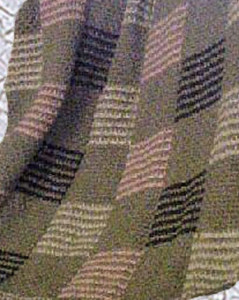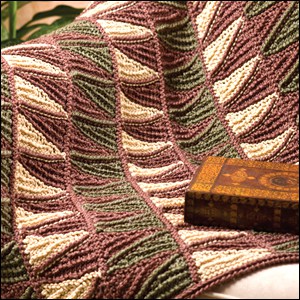Writing Tunisian crochet patterns is very similar to writing knitting patterns. If you’re familiar with knitting patterns, it will come naturally.
Due to the evolution of Tunisian crochet, I’ve found that there are some things that I wish I’d never done in my older books. Once you write something down in a certain way and it’s published, it’s very hard to get something written differently in later publications.
Things seem to stick, especially when you are the first to come up with different techniques or ideas. I had already had several books written before I discovered that some things are going to have to change.

So, here are some things that come to mind due to the evolution of Tunisian crochet and how I’d like to fix them. In other words, if I had known then what I know now, I would have done things differently.
Typical Closing
When you’re working in Tunisian crochet, you have a typical closing, also called a return pass. Here is the typical return pass:
Yarn over and pull through one loop on hook, [yarn over and pull through two loops on hook] across.
This has got to change. That first instruction of “yarn over and pull through one loop on hook” is the culprit. What happens when you have to do that two or sometimes three times in lace stitch patterns? Here, let me show you.
[Yarn over and pull through one loop on hook] 3 times, yarn over and pull through 4 loops on hook,…
Now when you get to the next row, how do you specify where to stitch the last stitch? Do you say “insert hook in first yarn-over-and-pull-through-one-loop-on-hook?” That’s crazy speak.
Here is how I have resolved it. A yarn-over-and-pull-through-one-loop-on-hook is a CHAIN! Think about it. Yarn over and pull through one loop. Yep, that’s a chain!
Now, if we use this instruction, we can easily designate the next row as stitching into the first, second or third chain.
Chain 3, yarn over and pull through 4 loops on hook,…
Definitely, I’d like to see this idea start to stick in Tunisian crochet patterns. The Tunisian crochet evolution requires it.

Right-Hand Specific
Do you know how many left-handed people think that it’s impossible for someone to do Tunisian crochet because they’re left-handed? And, this is why:
Insert hook from right-to-left under the front vertical bar, yarn over and pull a loop through.
My preferred method is to say:
Insert hook from side-to-side under the front vertical bar, yarn over and pull a loop through.
There, fixed. It can be defined even further by saying:
Right-to-left for right-handers and left-to-right for left-handers.
Make 1
In one of my books, I defined a Make 1 as follows:
Insert hook from front-to-back of your work under the yarn over from the previous row.
I did this for one reason only. It was to distinguish the yarn over from the other stitches. You’re actually making a Tunisian knit stitch, but the stitch below looks a little different and sometimes the bars are hard to see. So, in an effort to distinguish it from other stitches, I called it something different.

This came back to haunt me when I did my Tunisian Stitch Guide because, in the stitch guide, the symbol is a Tunisian knit stitch…. because it IS a Tunisian knit stitch and has been all along. My effort to make things easier may not have been such a swell idea.
Abbreviations in All Caps
Is it necessary? Certainly not. You can capitalize the letters if you want, or not.
Row 3: Skip first vertical bar, TKS across…
is the same thing as
Row 3: Skip first vertical bar, tks across…
Skip First Vertical Bar
The typical Tunisian crochet row starts by skipping the first vertical bar… on every single row. There are exceptions, of course. But, this is typical. If you don’t want to write it every single time, that’s fine. Just put it up in the pattern notes that you will skip the first vertical bar of every row. It saves space and headaches down the road should you forget to write it every. single. time.
Typical Closing
You have a typical closing for most rows of Tunisian crochet. It is described up there in the top of this post. If you don’t want to write it every single time, define it in the pattern notes. Just say that the typical closing is “Chain 1, [yarn over and pull through 2 loops on hook] across, until 1 loop remains on hook”. There, you’ve said it in the pattern notes. When you get to the instructions, you can now say “close normally.”
Again, this is the typical closing. If you’re working with a variety of closings in the same pattern, such as intricate lace, you can’t do this. But, you certainly can do this with most patterns.
Turning Your Work
Stop telling people that, in Tunisian crochet, you never turn your work. I’ve already busted that myth with this project from Crochet World, October 2009. (This pattern is only available in the magazine. You will have to look on used magazine and book sites like eBay and Amazon Resellers, if you’re trying to find it.)

And, besides, you *do* turn your work with double-ended Tunisian crochet, so it’s best to just stop passing around that rumor, right?
🙂
These are just off the top of my head. I’m sure there are more, but they’re not coming to me right now. If I think of any more, I’ll be sure to add them for you later. I just really wish that I had known then what I know now. I had no idea when I first started writing these patterns almost 20 years’ ago that we would need changes. It’s going to be really hard for me to convince the new publications that a change is necessary.
